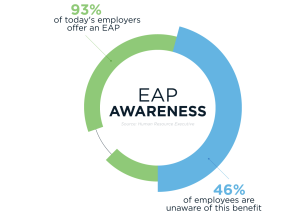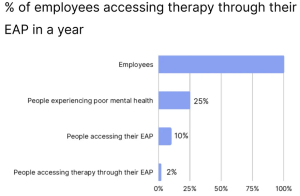Charting new courses to navigate mental health solutions in the workplace
When it comes to the important topic of providing workplace mental health support, the solution employers have historically chosen is the traditional Employee Assistance Program (or EAP).
More recently, forward-looking companies have begun to embrace innovative digital EAPs – tools that combine curated, self-guided cognitive behavioral therapy (CBT) modules with live and asynchronous coaching, short-term solution-focused counseling, and work-life services.
The ambition is that the digital EAPs better address mental health wellness in the workplace.
However, the fact is both approaches have been found wanting.
While traditional EAPs has a proven track record, they are often criticized for being hindered by accessibility barriers, lingering stigma, and low engagement.
On the other hand, digital EAPs offer convenience and accessibility, but are sometimes prohibitively expensive.
I would argue a more effective path forward for organizations and HR leaders is to embrace platforms and strategies that combine the strengths of both approaches while mitigating their weaknesses as well.
HR leaders are largely unaware of this “third way” option that can bridge the gaps between these two approaches.
But by becoming more familiar with it, they have the potential to revolutionize workplace mental health care and address the shortcomings found in traditional EAPs and digital EAPs.
The strengths and weaknesses of traditional EAPs
Employee Assistance Programs have long been a cornerstone of workplace mental health support.
Established in the mid-20th century, EAPs were designed to provide employees with confidential access to counseling services, specifically for alcoholism.
Eventually these programs expanded to combat drug addiction and support mental health.
The effectiveness of EAPs is well-documented; for instance, a study published by the Employee Assistance Professionals Association (EAPA), found that EAPs can reduce workplace absenteeism by up to 28% and improve productivity by 22%.
However, despite their benefits, traditional EAPs face significant challenges.
One of the primary issues is awareness.
Many employees are simply unaware of the services offered.

Source” https://allonehealth.com/5-ways-to-increase-eap-utilization/
TELUS Health’s monthly Mental Health Index from 2023 revealed that only two in five employees even knew about their EAPs
A further 29% of workers who had heard of them didn’t know what they offered.
As such, the proportion of employees accessing traditional EAP services is low:

Another challenge is employees are hesitant to use them due to concerns about confidentiality and stigma.
The rise of digital EAPs
In contrast, digital EAPs have gained traction for their ability to provide speedy, accessible support.
Platforms like Lyra, Spring, and Modern all offer virtual therapy sessions, often with greater flexibility than traditional EAPs as well as more personalized care and concierge support.
These types of platforms have become popular in the wake of Covid-19, which accelerated the adoption of greater mental health support.
A report by McKinsey & Company noted a significant increase in both the perception and use of digital mental health services since 2020.
But despite their advantages, digital EAPs also face criticism.
Digital EAPs are often questioned for their high costs, which can be 5-10 times more expensive than traditional EAPs.
Moreover, the fee-for-service business model used by digital EAPs incentivizes them to direct employees towards costly clinical care when more affordable and effective options may be available.
This financial structure can lead to a significant rise in an organization’s overall spending on employee mental health services.
The best of both worlds
As organizations seek to address these challenges, a new trend has emerged: the adoption of platforms and strategies that combine the strengths of traditional EAPs and digital EAPs.
These integrated approaches offer comprehensive mental health support while leveraging technology to enhance accessibility and reduce stigma.
New strategies and platforms are emerging that integrate the best features of both digital and traditional Employee Assistance Programs (EAPs), addressing issues like cost, adoption, and accessibility.
Companies are increasingly adopting models that provide employees with the option to choose between in-person counseling and virtual sessions based on their preferences and needs, and robust self-care tools to keep employees well.
This flexible approach caters to diverse employee preferences and ensures that individuals receive appropriate levels of care, thereby enhancing the overall effectiveness of mental health support.
Industry leaders are also increasingly advocating for these types of solutions.
As Claude Silver, chief heart officer at VaynerMedia, says: “Our employees now have access to proactive mental health support that resonates with their needs and lifestyles.”
Such models can also help de-stigmatize mental health support by normalizing the use of both digital and in-person resources.
Crafting engaging strategies for mental health care
It’s worth noting, however, that implementing effective new models requires thoughtful planning and a commitment to creating a supportive workplace culture.
Experts emphasize the importance of communication and education to ensure employees are aware of the available resources and feel comfortable accessing them.
Employers should provide regular training for managers and staff to recognize signs of mental distress and to foster an environment where mental well-being is openly discussed.
But, as the conversation around workplace mental health continues to evolve, the “third way” approach does start to resemble a balanced path forward.
By combining the reliability of traditional EAPs with the accessibility of digital EAPs, a comprehensive and flexible solution emerges that prioritizes employee wellbeing.
This approach not only addresses the shortcomings of each individual model but also creates a more inclusive and supportive workplace environment.
The future of workplace mental health lies in embracing innovation while recognizing the foundations laid by traditional approaches.
As organizations continue to navigate this landscape, the adoption of this third way can help ensure that all employees have access to the mental health support they need, ultimately fostering a healthier, more productive workforce.
